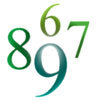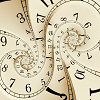Skip over navigation
In the table of possible scores, you need one 2, two 3s, three 4s, four 5s, five 6s, six 7s, five 8s, four 9s, three 10s, two 11s and one 12.
Working systematically using a table
You can fill in your dice one row at a time. You know that you need one 2, which must come from 1 + 1, so you need a 1 on your dice.
You also need two 3s. The only way to get 3s is from (my 1) + (your 2) (since my dice doesn't have a 2 and putting a zero on your dice would make it possible to get a total of only 1). So you need two 2s on your dice.
You also need three 4s, but so far you've only got one, which comes from (my 3) + (your 1). The others will have to come from (my 1) + (your 3), since you can't put any more 1s on your dice without ending up with too many 2s. So you need two 3s on your dice.
What else is missing? Definitely one 12 - which you can make as (my 8) + (your 4). So you'll need a 4.
Count the number of times each number comes up - it works!
Working logically thinking about totals
When I changed my 2 to an 8, I increased the total score of my dice by 6 points. If the two dice are to perform the same as two normal dice, the scores shouldn't get larger or smaller overall, so you should decrease the total score of your dice by 6 points.
You know that you don't want to have sums larger than 12, so you can't keep the 5 or 6 on your dice. So you can decrease your 5 and 6 by a total of 6 points between them. This table shows the options (remember that neither the 5 or the 6 should be sent to less than 1, because the smallest total possible should be 2).
So the options for your dice are 1, 2, 3, 4, 4, 1 and 1, 2, 3, 4, 2, 3. In the 1, 2, 3, 4, 4, 1 case, there will be two ways to make 12 (one from each of your two 4s) and two ways to make 2 (one from each of your 1s), which is not allowed. So let's see what happens for 1, 2, 3, 4, 2, 3:


Or search by topic
Number and algebra
Geometry and measure
Probability and statistics
Working mathematically
Advanced mathematics
For younger learners
Fair's Fair
Age 11 to 14
ShortChallenge Level 





- Problem
- Solutions
In the table of possible scores, you need one 2, two 3s, three 4s, four 5s, five 6s, six 7s, five 8s, four 9s, three 10s, two 11s and one 12.
Working systematically using a table
You can fill in your dice one row at a time. You know that you need one 2, which must come from 1 + 1, so you need a 1 on your dice.
| My dice | |||||||
|---|---|---|---|---|---|---|---|
| Your dice | 1 | 3 | 4 | 5 | 6 | 8 | |
| 1 | 2 | 4 | 5 | 6 | 7 | 9 | |
You also need two 3s. The only way to get 3s is from (my 1) + (your 2) (since my dice doesn't have a 2 and putting a zero on your dice would make it possible to get a total of only 1). So you need two 2s on your dice.
| My dice | |||||||
|---|---|---|---|---|---|---|---|
| Your dice | 1 | 3 | 4 | 5 | 6 | 8 | |
| 1 | 2 | 4 | 5 | 6 | 7 | 9 | |
| 2 | 3 | 5 | 6 | 7 | 8 | 10 | |
| 2 | 3 | 5 | 6 | 7 | 8 | 10 | |
You also need three 4s, but so far you've only got one, which comes from (my 3) + (your 1). The others will have to come from (my 1) + (your 3), since you can't put any more 1s on your dice without ending up with too many 2s. So you need two 3s on your dice.
| My dice | |||||||
|---|---|---|---|---|---|---|---|
| Your dice | 1 | 3 | 4 | 5 | 6 | 8 | |
| 1 | 2 | 4 | 5 | 6 | 7 | 9 | |
| 2 | 3 | 5 | 6 | 7 | 8 | 10 | |
| 2 | 3 | 5 | 6 | 7 | 8 | 10 | |
| 3 | 4 | 6 | 7 | 8 | 9 | 11 | |
| 3 | 4 | 6 | 7 | 8 | 9 | 11 | |
What else is missing? Definitely one 12 - which you can make as (my 8) + (your 4). So you'll need a 4.
| My dice | |||||||
|---|---|---|---|---|---|---|---|
| Your dice | 1 | 3 | 4 | 5 | 6 | 8 | |
| 1 | 2 | 4 | 5 | 6 | 7 | 9 | |
| 2 | 3 | 5 | 6 | 7 | 8 | 10 | |
| 2 | 3 | 5 | 6 | 7 | 8 | 10 | |
| 3 | 4 | 6 | 7 | 8 | 9 | 11 | |
| 3 | 4 | 6 | 7 | 8 | 9 | 11 | |
| 4 | 5 | 7 | 8 | 9 | 10 | 12 | |
Working logically thinking about totals
When I changed my 2 to an 8, I increased the total score of my dice by 6 points. If the two dice are to perform the same as two normal dice, the scores shouldn't get larger or smaller overall, so you should decrease the total score of your dice by 6 points.
You know that you don't want to have sums larger than 12, so you can't keep the 5 or 6 on your dice. So you can decrease your 5 and 6 by a total of 6 points between them. This table shows the options (remember that neither the 5 or the 6 should be sent to less than 1, because the smallest total possible should be 2).
| decrease by | 5 becomes | 6 becomes |
|---|---|---|
| 1, 5 | 4 | 1 |
| 2, 4 | 3 | 2 |
| 3, 3 | 2 | 3 |
| 4, 2 | 1 | 4 |
So the options for your dice are 1, 2, 3, 4, 4, 1 and 1, 2, 3, 4, 2, 3. In the 1, 2, 3, 4, 4, 1 case, there will be two ways to make 12 (one from each of your two 4s) and two ways to make 2 (one from each of your 1s), which is not allowed. So let's see what happens for 1, 2, 3, 4, 2, 3:
| My dice | |||||||
|---|---|---|---|---|---|---|---|
| Your dice | 1 | 3 | 4 | 5 | 6 | 8 | |
| 1 | 2 | 4 | 5 | 6 | 7 | 9 | |
| 2 | 3 | 5 | 6 | 7 | 8 | 10 | |
| 2 | 3 | 5 | 6 | 7 | 8 | 10 | |
| 3 | 4 | 6 | 7 | 8 | 9 | 11 | |
| 3 | 4 | 6 | 7 | 8 | 9 | 11 | |
| 4 | 5 | 7 | 8 | 9 | 10 | 12 | |
You can find more short problems, arranged by curriculum topic, in our short problems collection.
You may also like
Consecutive Numbers
An investigation involving adding and subtracting sets of consecutive numbers. Lots to find out, lots to explore.
Days and Dates
Investigate how you can work out what day of the week your birthday will be on next year, and the year after...

